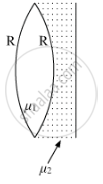Advertisements
Advertisements
प्रश्न
Find the maximum magnifying power of a compound microscope having a 25 diopter lens as the objective, a 5 diopter lens as the eyepiece and the separation 30 cm between the two lenses. The least distance for clear vision is 25 cm.
उत्तर
For the compound microscope, we have:
Power of the objective lens = 25 D
The focal length of the objective lens is given by
`f_0 = 1/(25 D) = 0.04 m = 4 cm`
Power of the eyepiece = 5 D
The focal length of the eyepiece is given by
`f_e = 1/(5D) =0.2 m =20 cm`
Least distance of clear vision, D = 25 cm
Separation between the objective and the eyepiece, L = 30 cm
Magnifying power is maximum when the image is formed by the eyepiece at the least distance of clear vision, i.e., D = 25 cm.
For the eyepiece, we have:
ve = -25 cm and fe = 20 cm
The lens formula is given by
`1/v_e = 1/u_e + 1/f_e`
`=> 1/u_e = 1/v_e -1/f_e`
`=>1/-25 -1/20= -((4+5))/100`
⇒ ue = `(-100)/9` = 11.11 cm
Let uo and vo be the object and image distance for the objective lens.
So, for the objective lens, the image distance will be
V0 = L - u0
v0 = 30 -11.11
⇒ v0 = 18.89 cm ....(1)
As the image produced is real , v0 =+18.89 cm
`1/u_0 = 1/v_0 -1/f_0`
=`1/18.89 - 1/4 = -0.197`
`u_0 =-5.07 cm` .....(2)
Maximum magnifying power of the compound microscope:
m=`v_0/u_0(1+D/f_e)`
=` -(18.89/-5.07) (1+25/20)`
=3.7225 × 2.25 =8.376
So, the maximum magnifying power of the compound microscope is 8.376.
APPEARS IN
संबंधित प्रश्न
A biconvex lens with its two faces of equal radius of curvature R is made of a transparent medium of refractive index μ1. It is kept in contact with a medium of refractive index μ2 as shown in the figure.

(a) Find the equivalent focal length of the combination.
(b) Obtain the condition when this combination acts as a diverging lens.
(c) Draw the ray diagram for the case μ1 > (μ2 + 1) / 2, when the object is kept far away from the lens. Point out the nature of the image formed by the system.
A biconvex lens made of a transparent material of refractive index 1.5 is immersed in water of refractive index 1.33. Will the lens behave as a converging or a diverging lens? Give reason.
Define the magnifying power?
name the factors on which 'limit of resolution' depends ?
The size of an object as perceived by an eye depends primarily on
To increase the angular magnification of a simple microscope, one should increase ______.
A child has near point at 10 cm. What is the maximum angular magnification the child can have with a convex lens of focal length 10 cm?
The angular magnification of a system is less than one. Does it mean that the image formed is inverted?
Why are the magnification properties of microscopes and telescopes defined in terms of the ratio of angles and not in terms of the ratio of sizes of objects and images?
An optical instrument used for angular magnification has a 25 D objective and 20 D eyepiece. The tube length is 25 cm when the eye is least strained. (a) Whether it is a microscope or a telescope? (b) What is the angular magnification produced?
A person wears glasses of power − 2.5 D. Is the person farsighted or nearsighted? What is the far point of person without the glasses?
How does focal length of a convex lens change with increase in wavelength of incident light?
Magnification for spherical mirrors m is given by ______.
The focal length of the objective of a telescope is 60 cm. To obtain a magnification of 20, the focal length of the eye piece should be:
